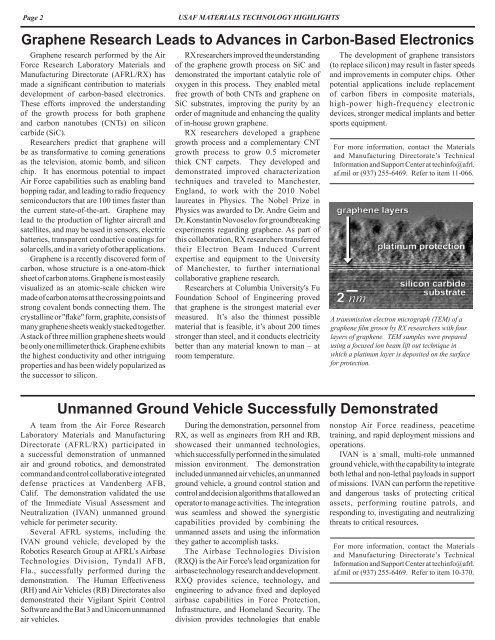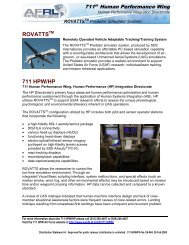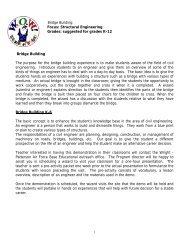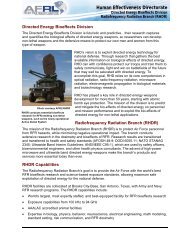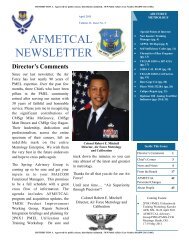AFRL Develops Improved Ballistic Armor - Wright-Patterson Air ...
AFRL Develops Improved Ballistic Armor - Wright-Patterson Air ...
AFRL Develops Improved Ballistic Armor - Wright-Patterson Air ...
You also want an ePaper? Increase the reach of your titles
YUMPU automatically turns print PDFs into web optimized ePapers that Google loves.
Page 2USAF MATERIALS TECHNOLOGY HIGHLIGHTSGraphene Research Leads to Advances in Carbon-Based ElectronicsGraphene research performed by the <strong>Air</strong>Force Research Laboratory Materials andManufacturing Directorate (<strong>AFRL</strong>/RX) hasmade a significant contribution to materialsdevelopment of carbon-based electronics.These efforts improved the understandingof the growth process for both grapheneand carbon nanotubes (CNTs) on siliconcarbide (SiC).Researchers predict that graphene willbe as transformative to coming generationsas the television, atomic bomb, and siliconchip. It has enormous potential to impact<strong>Air</strong> Force capabilities such as enabling bandhopping radar, and leading to radio frequencysemiconductors that are 100 times faster thanthe current state-of-the-art. Graphene maylead to the production of lighter aircraft andsatellites, and may be used in sensors, electricbatteries, transparent conductive coatings forsolar cells, and in a variety of other applications.Graphene is a recently discovered form ofcarbon, whose structure is a one-atom-thicksheet of carbon atoms. Graphene is most easilyvisualized as an atomic-scale chicken wiremade of carbon atoms at the crossing points andstrong covalent bonds connecting them. Thecrystalline or "flake" form, graphite, consists ofmany graphene sheets weakly stacked together.A stack of three million graphene sheets wouldbe only one millimeter thick. Graphene exhibitsthe highest conductivity and other intriguingproperties and has been widely popularized asthe successor to silicon.Unmanned Ground Vehicle Successfully DemonstratedA team from the <strong>Air</strong> Force ResearchLaboratory Materials and ManufacturingDirectorate (<strong>AFRL</strong>/RX) participated ina successful demonstration of unmannedair and ground robotics, and demonstratedcommand and control collaborative integrateddefense practices at Vandenberg AFB,Calif. The demonstration validated the useof the Immediate Visual Assessment andNeutralization (IVAN) unmanned groundvehicle for perimeter security.Several <strong>AFRL</strong> systems, including theIVAN ground vehicle, developed by theRobotics Research Group at <strong>AFRL</strong>’s <strong>Air</strong>baseTechnologies Division, Tyndall AFB,Fla., successfully performed during thedemonstration. The Human Effectiveness(RH) and <strong>Air</strong> Vehicles (RB) Directorates alsodemonstrated their Vigilant Spirit ControlSoftware and the Bat 3 and Unicorn unmannedair vehicles.RX researchers improved the understandingof the graphene growth process on SiC anddemonstrated the important catalytic role ofoxygen in this process. They enabled metalfree growth of both CNTs and graphene onSiC substrates, improving the purity by anorder of magnitude and enhancing the qualityof in-house grown graphene.RX researchers developed a graphenegrowth process and a complementary CNTgrowth process to grow 0.5 micrometerthick CNT carpets. They developed anddemonstrated improved characterizationtechniques and traveled to Manchester,England, to work with the 2010 Nobellaureates in Physics. The Nobel Prize inPhysics was awarded to Dr. Andre Geim andDr. Konstantin Novoselov for groundbreakingexperiments regarding graphene. As part ofthis collaboration, RX researchers transferredtheir Electron Beam Induced Currentexpertise and equipment to the Universityof Manchester, to further internationalcollaborative graphene research.Researchers at Columbia University's FuFoundation School of Engineering provedthat graphene is the strongest material evermeasured. It’s also the thinnest possiblematerial that is feasible, it’s about 200 timesstronger than steel, and it conducts electricitybetter than any material known to man – atroom temperature.During the demonstration, personnel fromRX, as well as engineers from RH and RB,showcased their unmanned technologies,which successfully performed in the simulatedmission environment. The demonstrationincluded unmanned air vehicles, an unmannedground vehicle, a ground control station andcontrol and decision algorithms that allowed anoperator to manage activities. The integrationwas seamless and showed the synergisticcapabilities provided by combining theunmanned assets and using the informationthey gather to accomplish tasks.The <strong>Air</strong>base Technologies Division(RXQ) is the <strong>Air</strong> Force's lead organization forairbase technology research and development.RXQ provides science, technology, andengineering to advance fixed and deployedairbase capabilities in Force Protection,Infrastructure, and Homeland Security. Thedivision provides technologies that enableThe development of graphene transistors(to replace silicon) may result in faster speedsand improvements in computer chips. Otherpotential applications include replacementof carbon fibers in composite materials,high-power high-frequency electronicdevices, stronger medical implants and bettersports equipment.For more information, contact the Materialsand Manufacturing Directorate’s TechnicalInformation and Support Center at techinfo@afrl.af.mil or (937) 255-6469. Refer to item 11-066.A transmission electron micrograph (TEM) of agraphene film grown by RX researchers with fourlayers of graphene. TEM samples were preparedusing a focused ion beam lift out technique inwhich a platinum layer is deposited on the surfacefor protection.nonstop <strong>Air</strong> Force readiness, peacetimetraining, and rapid deployment missions andoperations.IVAN is a small, multi-role unmannedground vehicle, with the capability to integrateboth lethal and non-lethal payloads in supportof missions. IVAN can perform the repetitiveand dangerous tasks of protecting criticalassets, performing routine patrols, andresponding to, investigating and neutralizingthreats to critical resources.For more information, contact the Materialsand Manufacturing Directorate’s TechnicalInformation and Support Center at techinfo@afrl.af.mil or (937) 255-6469. Refer to item 10-370.


